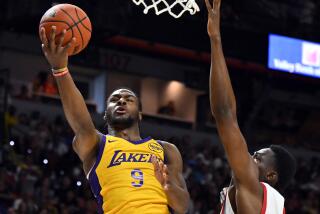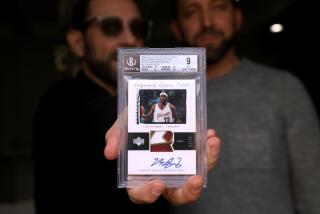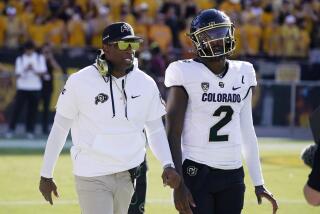What’s in the Cards for Sports Fans : Pro football and basketball are joining baseball in the booming market for collectible pasteboards.
Gregory Sanchez sometimes apologizes for the inadequacies of a collection that includes 800 football cards, 2,000 basketball cards and about 400,000 trading cards of the baseball variety.
“I would have a lot more basketball cards, but they’ve been hard to find at times,” explained Sanchez, a 36-year-old manager of a resort near Frazier Park. “Basketball and football cards haven’t been distributed as well as baseball cards.”
Mindful of potential customers such as Sanchez, professional athletic leagues and a number of companies are entering the trading card business. The new players in this business hope to score in the wide-open field for basketball and football trading cards, estimated to have a combined sales value of only about $13 million in 1988.
Hundreds of thousands of hobbyists trade or sell or save sports trading cards, collectibles that tend to appreciate in value with age. Sanchez, a sports fan who prefers basketball, is part of a burgeoning customer base that is rapidly convincing sports marketing firms that profits--big profits--are in the cards.
The National Football League kicked things off earlier this month when it introduced a product called “The Official NFL Card,” a package containing 14 player cards and bonuses--a card commemorating Super Bowls and a scratch-off card for prizes. The NFL, which manufactures its cards, will butt heads with Score Inc., a Dallas-area firm that began to distribute NFL-licensed cards this summer. The NFL and Score are lining up their gridiron collectibles against a version produced by Topps, the established producer of NFL-licensed cards.
The competition will expand again when the National Basketball Assn. takes a shot by introducing NBA Hoops Cards through the Durham, N.C.-based Liggett Group, a candy- and tobacco-making firm that will produce and distribute cards bearing photographs of professional round-ballers. The Hoops cards will go one-on-one against the Philadelphia-based Fleer Corp., the veteran producer of NBA basketball cards. While Fleer’s product is licensed by the NBA, the Liggett Group’s entry will carry the official endorsement of the league.
The new competitors in the card market hope to challenge baseball card producers, firms that have long dominated the sports collectibles industry. The baseball card business was once dominated by New York-based Topps Co., the sole maker of the major league collectibles until 1980. The industry is now highly competitive, accommodating a Chicago-area firm called Donruss and two other major producers. In fact, industry observers say the new players helped generate the boom in the sale of new baseball cards, boosting it from a $25-million business in 1980 to a $350-million enterprise in 1988.
Promotional Campaign
“The basketball and football card market is taking the same course that baseball took when competitors entered the market,” observed Jeffrey Kurowski, an editor at Sports Collectors Digest, an Iola, Wis., publication that assesses the value of vintage trading cards and other sports collectibles. “Baseball has a gigantic (card) market. By making its own card, the NFL is stimulating more interest in football cards . . . and the NBA is generating more interest in (basketball) cards by officially backing a product.”
The NBA and the Liggett Group are now gearing up for an advertising and promotional program for the Hoops card, which will debut in stores in mid-November, according to Don Fish, the NBA’s vice president for marketing.
“There’s a mania for all sports trading cards now,” Fish said. “A lot of things were put together real quickly to put this deal together. There are 100,000 to 150,000 new collectors each year. We wanted to be prepared to take advantage of this (interest).”
Liggett also arranged to market and distribute the NFL’s official football cards in conjunction with Pro-Set, a Dallas-based firm. Tony Dale, publishing director for NFL Properties, said the NFL will spend about $1.5 million this year and $3 million to $5 million in 1990 to tout the cards. Media vehicles will include cable television’s Nickelodeon, publications such as Boys’ Life and sports magazines such as Sports Illustrated and Street & Smith. “With the astounding growth of trading card sales the past few years, it seemed appropriate to get involved in cards,” Dale said. “We’re interested in the collector market, which is primarily adults. But we’re also interested in youngsters because kids are more enthusiastic about baseball cards and we hope to tap into that.”
‘Faces Create Identity’
The NFL hopes to stimulate youthful interest in the cards and the sport through its promotional campaign. Dale said football card sales have traditionally lagged far behind the baseball collectibles partly because younger sports fans--ages 6 to 15--find it more difficult to identify with the game’s players.
“We deal with the unfortunate obstacle of player helmets,” Dale explained. “Young fans don’t see (player) faces and faces create identity for players.”
To compensate, the NFL produced a card that shows two sides of its athletes. One side shows a player in action--sprinting, throwing or poised to make a block or tackle. The same player appears sans helmet on the flip side.
The NFL and other new competitors are already generating new interest in the football and basketball card market, according to James Echeandria, head of American Consulting Corp., Orlando, a Florida-based consultant to the confectionary food and trading card industries.
“The common wisdom was that football cards don’t sell,” Echeandria said. “(NFL) Pro-Set and Score are proving that thinking is wrong. Football card sales could more than quadruple . . . and easily reach $50 million by the end of the year.”
NFL and NBA executives hope to generate some new sales by promoting their cards at card trading shows, marketplaces that have been dominated by baseball collectibles. While a 1984 Michael Jordan basketball card fetches about $50 and a 1976 Walter Payton football card might sell for $100, those classic cards cannot compare to the valued collectibles in baseball. Buoyed by the heavy demand for all baseball cards, a 1952 Mickey Mantle sells for $6,500 and a 1909 Honus Wagner nets a whopping $100,000.
Greg Sanchez, who has trudged through card shows in a disappointing search for football and basketball cards, hopes the NBA and the NFL successfully cultivate the trade show market.
“Basketball and football need more of a presence at shows because people who collect cards as an investment are a big part of the market,” Sanchez said. “Collectors are like athletes. Some are in it for the love of the sport, and some are in it for the money.”
More to Read
Go beyond the scoreboard
Get the latest on L.A.'s teams in the daily Sports Report newsletter.
You may occasionally receive promotional content from the Los Angeles Times.










